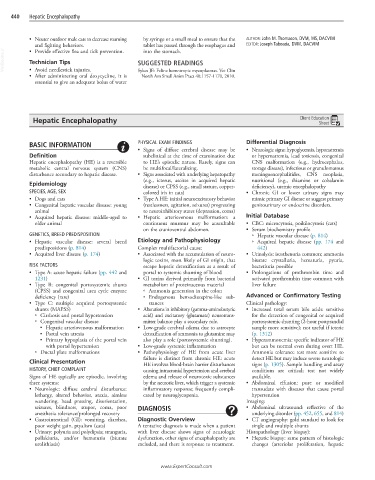Page 904 - Cote clinical veterinary advisor dogs and cats 4th
P. 904
440 Hepatic Encephalopathy
• Neuter outdoor male cats to decrease roaming by syringe or a small meal to ensure that the AUTHOR: John M. Thomason, DVM, MS, DACVIM
and fighting behaviors. tablet has passed through the esophagus and EDITOR: Joseph Taboada, DVM, DACVIM
into the stomach.
VetBooks.ir Technician Tips SUGGESTED READINGS
• Provide effective flea and tick prevention.
• Avoid needlestick injuries.
• After administering oral doxycycline, it is Sykes JE: Feline hemotropic mycoplasmas. Vet Clin
North Am Small Anim Pract 40:1157-1170, 2010.
essential to give an adequate bolus of water
Hepatic Encephalopathy Client Education
Sheet
BASIC INFORMATION PHYSICAL EXAM FINDINGS Differential Diagnosis
• Signs of diffuse cerebral disease may be • Neurologic signs: hypoglycemia, hyponatremia
Definition subclinical at the time of examination due or hypernatremia, lead toxicosis, congenital
Hepatic encephalopathy (HE) is a reversible to HE’s episodic nature. Rarely, signs can CNS malformation (e.g., hydrocephalus,
metabolic central nervous system (CNS) be multifocal/lateralizing. storage disease), infectious or granulomatous
disturbance secondary to hepatic disease. • Signs associated with underlying hepatopathy meningoencephalitides, CNS neoplasia,
(e.g., icterus, ascites in acquired hepatic nutritional (e.g., thiamine or cobalamin
Epidemiology disease) or CPSS (e.g., small stature, copper- deficiency), uremic encephalopathy
SPECIES, AGE, SEX colored iris in cats) • Chronic GI or lower urinary signs may
• Dogs and cats • Type A HE: initial neuroexcitatory behavior mimic primary GI disease or suggest primary
• Congenital hepatic vascular disease: young (restlessness, agitation, seizures) progressing genitourinary or endocrine disorders.
animal to neuroinhibitory states (depression, coma)
• Acquired hepatic disease: middle-aged to • Hepatic arteriovenous malformation: a Initial Database
older animal continuous murmur may be auscultable • CBC: microcytosis, poikilocytosis (cats)
on the cranioventral abdomen. • Serum biochemistry profile
GENETICS, BREED PREDISPOSITION ○ Hepatic vascular disease (p. 814)
• Hepatic vascular disease: several breed Etiology and Pathophysiology ○ Acquired hepatic disease (pp. 174 and
predispositions (p. 814) Complex multifactorial cause: 442)
• Acquired liver disease (p. 174) • Associated with the accumulation of neuro- • Urinalysis: isosthenuria common; ammonia
logic toxins, most likely of GI origin, that biurate crystalluria, hematuria, pyuria,
RISK FACTORS escape hepatic detoxification as a result of bacteriuria possible
• Type A: acute hepatic failure (pp. 442 and portal to systemic shunting of blood • Prolongations of prothrombin time and
1231) • GI toxins derived primarily from bacterial activated prothrombin time common with
• Type B: congenital portosystemic shunts metabolism of proteinaceous material liver failure
(CPSS) and congenital urea cycle enzyme ○ Ammonia generation in the colon
deficiency (rare) ○ Endogenous benzodiazepine-like sub- Advanced or Confirmatory Testing
• Type C: multiple acquired portosystemic stances Clinical pathology:
shunts (MAPSS) • Alterations in inhibitory (gamma-aminobutyric • Increased total serum bile acids: sensitive
○ Cirrhosis and portal hypertension acid) and excitatory (glutamate) neurotrans- for the detection of congenital or acquired
○ Congenital vascular disease mitter balance play a secondary role. portosystemic shunting (2-hour postprandial
Hepatic arteriovenous malformation • Low-grade cerebral edema due to astrocyte sample more sensitive); not useful if icteric
■
Portal vein atresia detoxification of ammonia to glutamine may (p. 1312)
■
Primary hypoplasia of the portal vein also play a role (portosystemic shunting). • Hyperammonemia: specific indicator of HE
■
with portal hypertension • Low-grade systemic inflammation but can be normal even during overt HE.
○ Ductal plate malformations • Pathophysiology of HE from acute liver Ammonia tolerance test more sensitive to
failure is distinct from chronic HE: acute detect HE but may induce severe neurologic
Clinical Presentation HE involves blood-brain barrier disturbances signs (p. 1305). Sample handling and assay
HISTORY, CHIEF COMPLAINT causing intracranial hypertension and cerebral conditions are critical; test not widely
Signs of HE typically are episodic, involving edema and release of neurotoxic substances available.
three systems: by the necrotic liver, which trigger a systemic • Abdominal effusion: pure or modified
• Neurologic: diffuse cerebral disturbance: inflammatory response; frequently compli- transudate with diseases that cause portal
lethargy, altered behavior, ataxia, aimless cated by neuroglycopenia. hypertension
wandering, head pressing, disorientation, Imaging:
seizures, blindness, stupor, coma, poor DIAGNOSIS • Abdominal ultrasound: reflective of the
anesthesia tolerance/prolonged recovery underlying disorder (pp. 452, 655, and 814)
• Gastrointestinal (GI): vomiting, diarrhea, Diagnostic Overview • CT angiography: gold standard to look for
poor weight gain, ptyalism (cats) A tentative diagnosis is made when a patient single and multiple shunts
• Urinary: polyuria and polydipsia; stranguria, with liver disease shows signs of neurologic Histopathology (liver biopsy):
pollakiuria, and/or hematuria (biurate dysfunction, other signs of encephalopathy are • Hepatic biopsy: same pattern of histologic
urolithiasis) excluded, and there is response to treatment. changes (arteriolar proliferation, hepatic
www.ExpertConsult.com

